|
 Lachnella villosa Lachnella villosa
SynonymsCyphella villosa
Peziza villosa
Cyphella curreyi
BiostatusPresent in region - Exotic
Images (click to enlarge)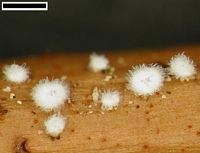
Caption: scale=0.5mm
Owner: J.A. Cooper | 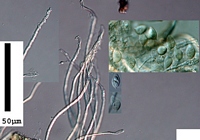
Caption: encrusted hairs and spores.
Owner: J.A. Cooper | 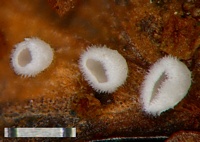
Owner: J.A. Cooper | 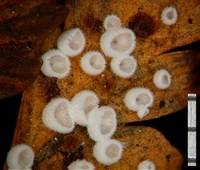
Owner: J.A. Cooper | 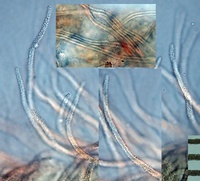
Caption: hairs (melzers)
Owner: J.A. Cooper | 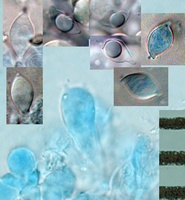
Caption: spores and basidium
Owner: J.A. Cooper |
Article: Cunningham, G.H. (1963). The Thelephoraceae of Australia and New Zealand. New Zealand Department of Scientific and Industrial Research, Bulletin 145: 359 p. Wellington:.
Description: Pilei annual, scattered or more usually crowded in small groups, membranous, at first
subglobose, becoming pezizaeform, 0.2-1 mm diameter, attached by brief bases; pileus
exterior white, tomentose with filiform abhymenial hairs which are 4-6 µm diameter,
aseptate, unbranched, apices rounded, sometimes inflated at or below apices, walls 0.5-1 µm
thick, densely and finely encrusted with somewhat fugacious crystals; margin inturned,
fimbriate; hymenial surface even, concave, white becoming cream. Context white, to 75 µm
thick, of radiately arranged parallel hyphae, walls tinted in a few outer hyphae; generative
hyphae 3.5-4 µm diameter, walls 0.25 µm thick, hyaline. Hymenial layer to 60 µm deep, a
close palisade of basidia and paraphyses. Basidia subclavate, 35-60 x 8-12 µm, bearing 2-4
spores; sterigmata erect, slender; to 6 µm long. Paraphyses subclavate, 22-45 x 6-8 µm.
Spores obovate with bluntly acuminate bases, or oval, some ovate, apiculate, 10-12 x 7-9 µm,
walls smooth, hyaline, 0.5 µm thick.
Habitat: HABITAT: Scattered or crowded on bark of dead branches and twigs.
Distribution:
DISTRIBUTION: Europe, North America, Australia, New Zealand.
Notes:
From L. alboviolascens the species is separated by the obovate, oval, or ovate spores of
moderate size; and from others of the section by the thin-walled, encrusted abhymenial hairs.
|